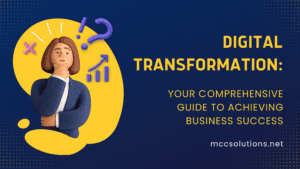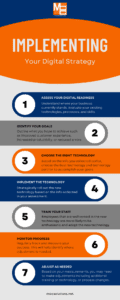
Digital Transformation: Your Comprehensive Guide to Achieving Business Success
Digital transformation (DX) integrates advanced technologies into business operations to bolster productivity, efficiency, and customer experience. Forecasts suggest DX spending will escalate from $1.6 trillion in 2022 to $3.4 trillion by 2026 (Statista Research). It’s not merely about tech adoption but a holistic reimagining of business operations and value delivery. With 27% of senior executives viewing DX as a survival necessity (Cleverism), it’s clear that embracing digital transformation is vital for businesses to remain competitive and prosperous in the digital era. For instance, companies like Amazon and Netflix have successfully leveraged digital transformation to disrupt traditional industries and gain a competitive edge.
This blog post will guide you through the key steps to successfully implementing digital transformation initiatives, including a detailed process for assessing your digital readiness, and developing a robust digital strategy tailored to your business’s unique needs and goals.
Analog Technology in Business
While analog technology may be reliable and familiar, it does come with its fair share of disadvantages. For instance, analog office technologies like fax machines, landline telephones, and overhead projectors operate through analog signals, which are prone to external disruptions. The limited scalability of analog systems can lead to subpar results and performance. Analog cables can be costly and vulnerable to outside factors. These issues can obstruct business productivity and efficiency. However, transitioning to digital solutions is not as daunting as it may seem. The benefits of digital technology, such as improved scalability, reduced costs, and enhanced productivity, far outweigh the challenges of analog technology.
Common Challenges of Using Analog Technology in Business

- Limited Scalability: Analog systems, such as older copiers or phone systems, need to scale better, making it difficult for businesses to adapt as they grow.
- Inefficiency: Paper documents and manual processes often consume significant time and resources, reducing a business’s overall efficiency. A 2020 marketing article from Thomson Reuters states that in 70% of surveyed organizations, using technology to simplify workflows and automate manual processes was a top priority.
- Vulnerability to Physical Damage: Paper documents are susceptible to fire, water damage, or loss, putting vital business information at risk. One lost document can cost up to $350 in time and labor, and businesses spend roughly $1500 per file cabinet to maintain stored paper documents.
- Lack of Integration: Analog systems lack integration with digital tools, making data sharing and collaboration difficult.
- Cost: Maintaining and repairing older analog systems can be more expensive in the long run compared to digital alternatives.
- Limited Access: Information stored in analog systems like paper documents is less accessible, particularly for remote workers.
- Signal Degradation: Analog systems can suffer from signal degradation, resulting in a loss of data integrity over time or distance.
- Environmental Impact: Reliance on paper documents contributes to deforestation and climate change. In the U.S. alone, offices use roughly 12.1 trillion sheets of paper per year, and 40% of printed paper in the U.S. ends up in the trash (The World Counts)
The Power of Digital Transformation

Digital transformation is the comprehensive integration of digital technology into business operations, fundamentally altering how value is delivered to customers. This broad concept ranges from process automation, which boosts efficiency by 40%, to exploring tech-driven business models. It fuels innovation, accelerates product or market development by 36%, and enhances customer experience by 35% through personalized, on-demand services. Moreover, it enables data-driven decision-making, offering insights for rapid adaptation to market changes.
Solving Common Analog Problems through Digital Transformation
Document Management: Shifting from physical to digital documents enhances business efficiency and accessibility. Document management software allows quick, location-independent access to information, crucial for remote work. Digital files can be easily searched and organized, improving internal operations and customer service. Workflow automation further streamlines operations by eliminating manual processes, reducing errors, freeing up employee time, and providing an audit trail for process monitoring and regulatory compliance. Therefore, digital document management and automated workflows significantly boost productivity, cut costs, and improve operational efficiency.
Postage and Shipping: Digital postage and shipping solutions revolutionize logistics by automating label printing, cost calculation, and shipment tracking to reduce errors and enhance productivity. They eliminate manual tasks, freeing employees for more critical work. These digital tools also significantly speed up processing, leading to quicker deliveries and increased revenue. Their integration allows for robust analytics and reporting, helping businesses identify and rectify bottlenecks for long-term efficiency. In short, digital postage and shipping solutions offer a more intelligent, quicker, and more efficient approach to managing shipping operations.
Audio Visual Technology: Digital audio-visual solutions, such as video conferencing tools, LED projectors, and automation systems, revolutionize business operations. Video conferencing enables real-time collaboration across locations, fostering quick decision-making and travel savings. LED projectors elevate presentations with high-definition visuals and easy data sharing, promoting collaborative discussions. Automation systems streamline functions like lighting and temperature for seamless presentations, saving setup time. Overall, digital AV solutions enhance business communication, collaboration, and efficiency.
Cloud Calling VoIP Technology: VoIP technology, such as Cisco Webex, replaces traditional phone systems, offering superior call quality and cost savings by transmitting voice calls over the Internet. Modern VoIP systems enhance customer service with features like automatic call distribution and CRM software integration for personalized service. They also offer unique features like voicemail to email transcription, call forwarding, auto-attendant, and mobile device integration, improving productivity and flexibility. Overall, VoIP provides a versatile and cost-effective communication solution, boosting operational efficiency and customer service in businesses.
Security Cameras and Access Control: Digital security systems, such as high-definition surveillance cameras and access control systems, provide a strong defense for businesses. The cameras deliver clear images, integrate with facial recognition and license plate reading software, and offer remote access for anytime monitoring. They also detect motion, record automatically, and send alerts. Digital access systems, which can be remotely deactivated and track usage, replace traditional keys for secure access control. Together, these digital systems boost security, streamline operations, and help businesses protect their assets and ensure safety.
Implementing a Digital Transformation Strategy
Transitioning from analog to digital is a significant step, but it’s one that puts you in control of your business’s future. It requires a well-thought-out strategy and the right technologies. By leveraging existing solutions or investing in new ones, depending on your organization’s specific needs, you can steer your business toward a more efficient and competitive future. Here’s how to go about it:

Assess your digital readiness: Understand your business’s current digital maturity. This involves evaluating your existing technology, skills, and processes.
Identify your goals: Outline what you hope to achieve through digital transformation. This could be anything from improving customer experience to increasing operational efficiency.
Choose the right technology: Based on your assessment and goals, choose the technology that best suits your needs. You should start with essential solutions and gradually expand as you grow. Remember, digital transformation is a journey, not a destination. Start small, but start now. The benefits are too significant to ignore.
Implement the technology: Strategically roll out the new technology, prioritizing based on the assessment data. Partnering with a tech expert can expedite this process and minimize business disruption.
Train your staff: Ensure your employees are well-versed in the new technology. This might involve training sessions or workshops. According to a McKinsey report, 70% of digital transformations fail due to employee resistance. Employees who are well-versed in the new technology are more likely to be enthusiastic about and adopt it.
Monitor progress: Regularly track and measure the success of your digital transformation efforts. This will help you identify any gaps and make necessary adjustments.
Adjust as needed: Based on the information collected by measuring your success, make any necessary adjustments. These can include process changes, additional technology, or additional training.
The journey to digital transformation may seem daunting, but the right approach and tools can lead to increased efficiency, cost savings, and a competitive edge. So start your digital transformation journey today and set your business up for success in the digital age.
Ready to leap into digital transformation? Want to explore how the latest technology can enhance your business operations and security? Get in touch with our office technology experts today! We’d be delighted to guide you through the options and help identify the right solutions to meet your specific needs. Whether you have questions or are ready to request a demo, our team is here to support you on your path to digital excellence. Contact us now, and let’s get started revolutionizing your business together.



One Response